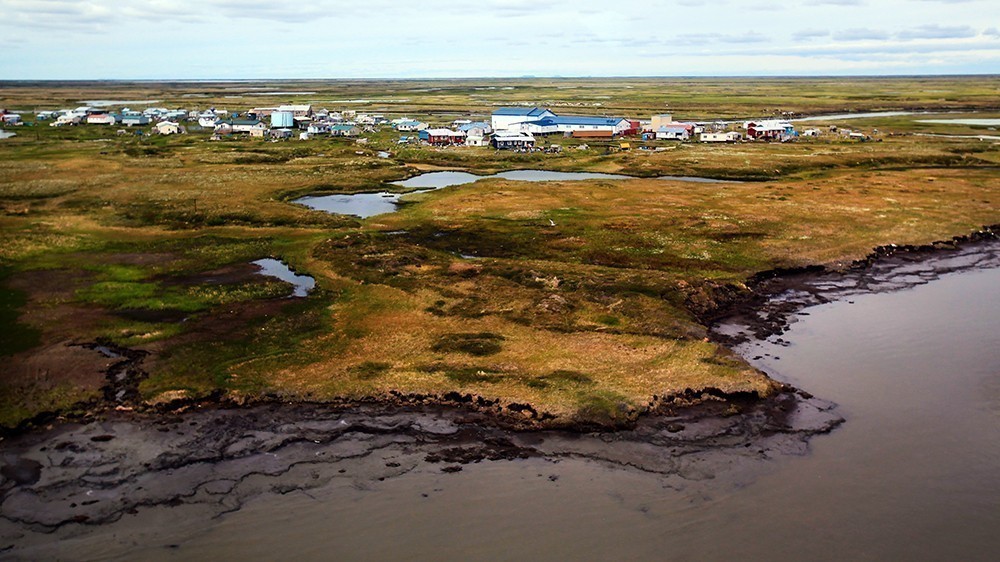
Newtok © 2009 Phil Daquila
THE ALASKA NATIVE TOWN of Newtok is expected to be under water by 2017, according to the Army Corps of Engineers (U.S. Army Corps of Engineers, 2009). The town is hardly an exception; there are eleven other tribal communities in the Arctic Circle that are in the same predicament (GAO, 2009). However, it is unlikely that these towns will be able to move to higher ground any time soon without the creation of a federal framework that can assist, overlook, and fund their relocation.
In the past 60 years, winter temperatures in Alaska have increased as much as six degrees Fahrenheit (EPA, 2016). As a result, arctic sea ice is decreasing in size and thickness and permafrost is thawing. This, in turn, has accelerated erosion and flooding, destroying local infrastructure and threatening the livelihoods of thousands of people—particularly Alaska Natives who live in the most vulnerable coastal areas of the Arctic Circle.
In order to shine a spotlight on these devastating impacts of climate change, President Obama traveled to Alaska in September 2015. On the third and final day of his trip, he traveled to two coastal towns in southwestern Alaska—Kotzebue and Dillingham—becoming the first president to visit Arctic Alaska. The town of Kotzebue (pop. 3,201) has been battling the impacts of climate change for years. Its main road runs right above the Kotzebue Sound—an arm of the Chukchi Sea—and is especially vulnerable to coastal erosion and arctic storms.
While in town, Obama took a tour of the Shore Avenue Project, a multi-year initiative to guard the city’s coastline against erosion.
“[The project] has protected the roadway and was paid for, in part, with federal transportation funds,” Obama wrote in his closing thoughts. “It’s a reminder of exactly why we fight so hard for infrastructure spending. It’s for communities like these” (Obama, 2015).
For many coastal communities in the same region, however, it is too late for erosion prevention and restoration efforts. The only adaptation strategy that can protect these communities from accelerating climate change is the relocation to higher and more solid ground. Unfortunately, while government agencies are spending millions of dollars on projects such as the Kotzebue Shore Avenue Project, there is an absence of funding for relocation efforts. According to Robin Bronen, an Anchorage human rights attorney and author of several reports on the situation in Newtok, this is rooted in the fact that U.S. climate change policy is primarily focused on helping victims rebuild in place after a disaster rather than moving whole communities out of harm’s way. As such, Bronen argues, there is no designated federal entity to guide, coordinate, or fund the relocation of villages. As long as government agencies are unable to change their approach from protection in place to relocation,1 these communities won’t be able to protect themselves from further impacts (Bronen, 2013; Bronen and Chapin, 2013).
Already in 2009, a report by the U.S. Government Accountability Office (GAO) concluded that out of 200 Native Alaskan coastal villages, 31 face imminent threat. At least 12 of the 31 voted to relocate (GAO, 2009)
Newtok
One of the villages that has opted to move to higher grounds is Newtok, a settlement of about 450 members of the Yup’ik people located along the Ninglick River near the Bering Sea in western Alaska (Newtok Village, 2015)
Since the mid-1950s, Newtok has lost about three-quarter of a mile of tundra that separated the town from the Ninglick River. A 1983 Ninglick River Erosion Assessment (requested by the City of Newtok and funded through the Alaskan Legislature) determined that between June 1957 and May 1983, the north bank of the river had eroded at an average annual rate of 19 to 88 feet, and that if this process isn’t slowed down, community structures would be endangered within 30 years (2013). Woodward Clyde, the consultants that were hired to prepare the 1983 assessment, concluded that, “relocating Newtok would likely be less expensive than trying to hold back the Ninglick River” (State of Alaska, 2016i).

Newtok © 2009 Phil Daquila
About ten years later, in response to the town’s worsening erosion problem, the Newtok Traditional Council—the town’s leadership—initiated a relocation planning process. After analyzing six different sites, it agreed on a new location—a site elevated on bedrock about nine miles south from Newtok across the Ninglick River. Newtok residents were already familiar with this site. Through the 1960s, residents spent summers in fish camps in Mertarvik—Yup’ik for “getting water from the spring”—while wintering in Newtok. After years of lobbying, Newtok finally got the title to Mertavik in 2003 (Community of Newtok and the Newtok Planning Group, 2011).
As Newtok was busy with its relocation efforts, the loss of land continued. When the Ninglick River overtook the Newtok River in 1996, the land buffer between the town and the Ninglick was lost, leaving Newtok even more susceptible to storm surges and flooding (Rawlings, 2015).
Between 2002 and 2013, seven floods—including six federally declared disasters—further accelerated erosion. The impacts of these floods were enormous. Water supplies were flooded, raw sewage was spread throughout the community, residents were displaced, subsistence food storage was destroyed, and essential utilities were shut down (Newtok Village, 2015).
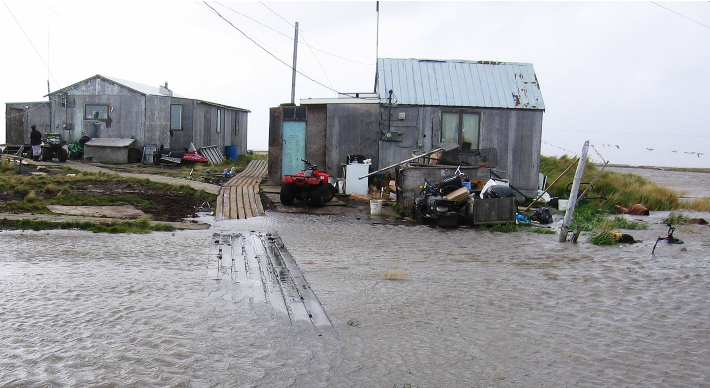
Newtok after 2005 Flood © 2005 Stanley Tom
Since being partly absorbed by the Ninglick River, the remaining Newtok River turned from a free flowing stream into a slough. As a result, the town’s waste (Newtok does not have running water and waste is disposed of in the river) is no longer able to flow out properly to the sea, creating a serious public health threat to the community.
Nearly 30 percent of infants in Newtok were hospitalized with lower respiratory tract infections between 1994 and 2004, including respiratory syncytial virus and pneumonia, according to a 2006 study conducted by the Yukon Kuskokwim Health Corporation and the Alaska Native Tribal Health Consortium. These infections have been linked to the substandard sanitation conditions, including inadequate potable water for drinking and personal hygiene, human waste contamination, and household overcrowding.
The report concluded that these conditions “appear to result from an initial lack of infrastructure development and failure to properly maintain existing infrastructure” (Community of Newtok and the Newtok Planning Group, 2011).

Newtok © 2009 Phil Daquila
Piecemeal funding and red tape
While the rapid deterioration of Newtok’s facilities and infrastructure has adversely impacted the quality of life, relocation is still a long way away. In fact, not much has happened since the town obtained the deed of Mertavik twelve years ago. Delays in relocation efforts are primarily the result of piecemeal funding and extraordinary amounts of red tape. The Newtok Traditional Council is working with approximately 25 different federal and state government agencies to build the infrastructure and housing at their new site (Bronen, 2013).
For example, in 2007, the first three homes in Mertavik were constructed using grants from the Bureau of Indian Affairs (BIA) Housing Improvement Program (HIP). A year later, Newtok received $3.3 million in state aid, which enabled tribal leaders to begin building a barge landing at the new site to bring in building materials. In addition, this money was used to design and construct some of the road that leads from the barge landing to the yet to be half-completed evacuation center (which was partially funded in 2009). In 2011, Newtok received grants for three additional homes, two through the Association of Village Council Presidents (AVCP) Regional Housing Authority and the third from BIA. These three homes were constructed in 2012. In short, it took more than five years to built six homes, the foundation of an evacuation center, a piece of road, and a barge landing. And these were the most productive years since Newtok obtained the title to Mertarvik. Dozens more homes need to be built and Newtok is rapidly running out of time.
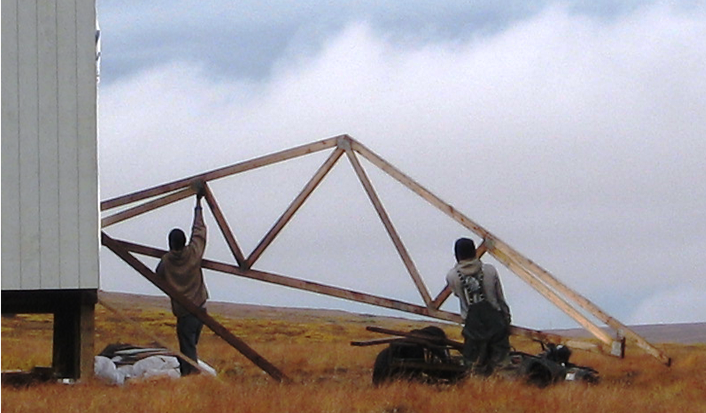
Newtok residents building a new home in Mertarvik © 2012 Stanley Tom
Securing further funding for the construction of new homes is critical to the success of the relocation. In 2014, a engineering survey of the 78 occupied housing units in the village of Newtok identified that only twelve were structurally sound and could be relocated to Mertarvik.
Through the Federal Emergency Management Agency (FEMA) Hazard Mitigation Grant Program (HMGP), Newtok received funding to relocate these twelve homes. It qualified for funding because the 2013 flood that devastated much of the town was declared a federal disaster, which is one of the program’s requirements. FEMA awarded the first phase of this grant, which enabled the State of Alaska to hire a contractor and engineer. The second phase of the grant will be awarded after an environmental review of the project is completed. The actual relocation of the twelve homes will most likely take place in the summer of 2017, according to the state website (State of Alaska, 2016).
While an achievement in its own right, moving these 12 homes will mean that there are 18 homes in Mertarvik. Leaving an additional 50 families uncertain about when they will be able to move to higher ground.
Residents, once hopeful, are unsure if they will ever relocate.
“We’ve been waiting so long. I don’t know,” Newtok resident Jimmy Charles told the Atlantic. “I’m beginning to lose a little bit of hope” (Semuels, 2015).
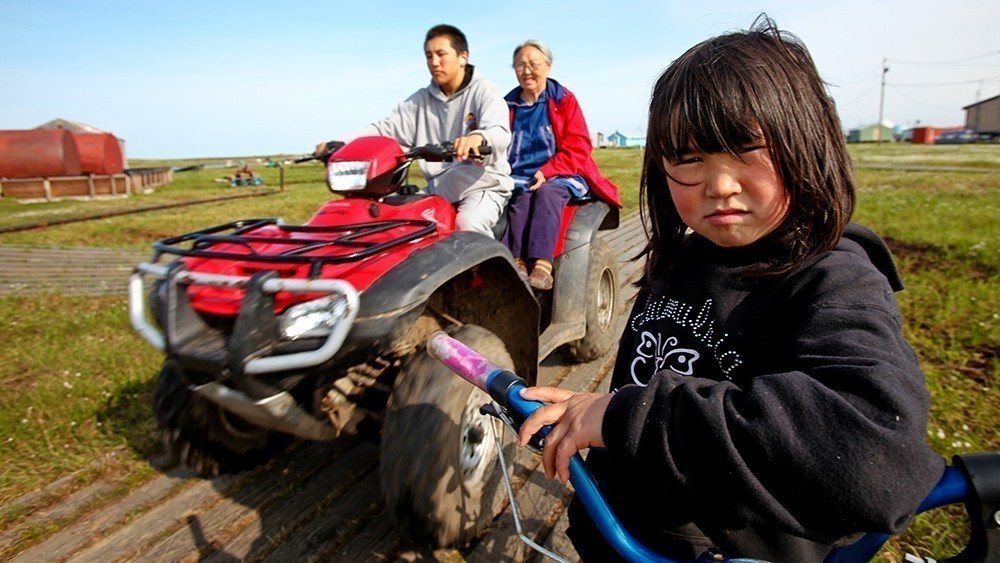
Newtok © 2009 Phil Daquila
Funding hurdles
While Newtok was able to get a small amount of FEMA funds though its Hazards Mitigation Grant Program, most of its relocation projecst do not meet the requirements to participate in the agency's grant programs. Besides HMGP, the Pre-Disaster Mitigation (PDM) grant program and the Flood Mitigation Assistance (FMA) program are available to the State of Alaska and Alaska Native villages.
The PDM grant program is designed to fund communities’ nationally competitive mitigation projects and planning efforts. Funding through this program doesn’t have to be triggered by a presidential disaster declaration (unlike the HMGP). However, one of the requirements is that all projects submitted must be cost-effective and technically feasible. While most of Newtok’s individual relocation projects are technically possible, they are far from inexpensive thanks to the cost of flying or shipping materials to Mertarvik—especially since the new site has no infrastructure in place. FEMA estimated that moving Newtok could cost around $400 million in total (Miller and Murphy, 2013). These high construction and relocation costs, in combination with Newtok’s low population, means that most projects are disqualified for a lack of cost effectiveness (Miller and Murphy, 2013; Rawlings, 2015).
The FMA Program provides funding to states, communities, and tribes for developing flood damage reduction projects, such as the elevation and relocation of structures. However, recipients must participate in the National Flood Insurance Program (NFIP) and have a flood mitigation plan. Unfortunately unincorporated villages such as Newtok can’t participate in the NFIP and are unlikely to have any homeowner or flood insurance, considering the town’s precarious location (Rawlings, 2015).
The HMGP has similar cost-effectiveness requirements as the PDM grant program, although funding is only available following a federal disaster declaration. Unfortunately, such declarations have never been honored for erosion—Newtok’s biggest threat (Rawlings, 2015).
Another hurdle is the cost share requirement of FEMA programs. All three programs stipulate that a state or a tribe match up to 25 percent of the total costs with FEMA. While the State of Alaska would provide the required 25 percent of the HMGP, it won’t do the same in the case of PDM and FMA grants, leaving tribes to assume 10 to 25 percent of project costs (Miller & Murphy, 2013).
It is unlikely that Newtok could raise even a 10 percent contribution.2 The town, like numerous other small Native Alaskan settlements, is built on a subsistence economy and lacks a monetary surplus for big investments, such as infrastructure or community buildings. Furthermore, according to the 2010 census, more than 30 percent of residents live below the poverty line (Newtok Village, 2015).
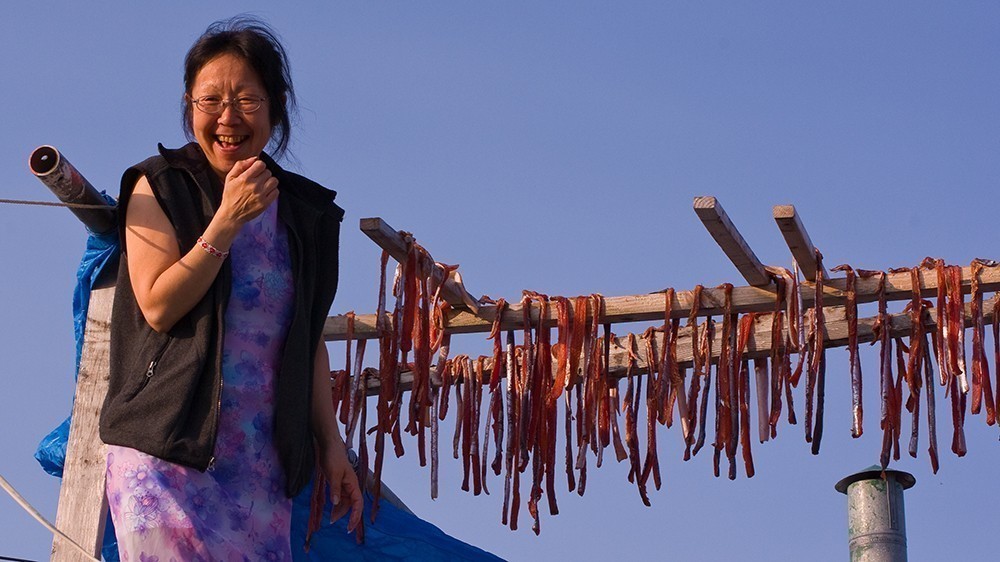
Newtok © 2009 Phil Daquila
Forced to settle permanently
In order to maintain their subsistence lifestyle, Alaska Native communities used to move around between a number of hunting and fishing camps. This migratory lifestyle came to an end in the late nineteenth and early twentieth century when the U.S. Bureau of Education required that all Alaska Native children to attend school. The locations of these schools were largely determined by barge accessibility that allowed the transport building materials. Infrastructure and other buildings sprang up around these schools, creating permanent settlements. By the mid-twentieth century, the majority Alaska Native tribes had settled in these permanent communities and could no longer adapt to their changing environment through traditional migration patterns (Bronen, 2013).
The school in Newtok was built in 1958, although high school students were required to travel to Bethel, St. Mary’s, or Anchorage for their education. About twenty years later, a high school was constructed in Newtok (Barnhardt, 2001).
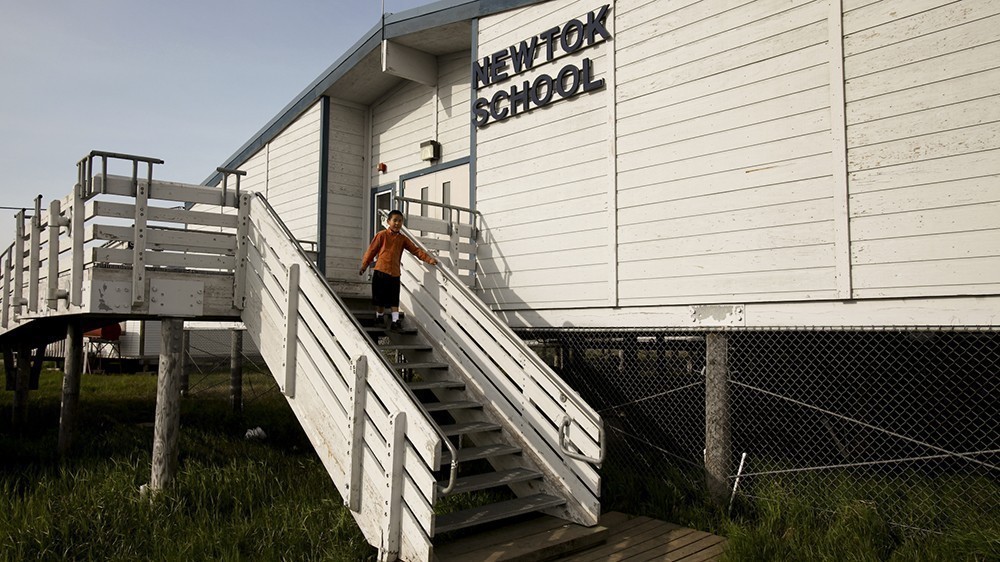
Newtok © Phil Daquila 2009
Catch-22
Today, the school district won’t build a new school in Mertarvik until 25 families live there, but no families want to live there without a school. Similar population thresholds must also be met to trigger funding for an airport and mail service (Community of Newtok and the Newtok Planning Group, 2011).
However, without a major influx of new homes and an airport, it will be difficult to convince anyone to live in Mertarvik. And without more substantial funding the town won’t be able to build anything.
The catch-22 doesn’t end there. While villagers are waiting to move to Mertarvik, their town continues to fall apart. The boardwalks connecting the homes are rotting and the majority of the occupied units are in poor to very poor conditions. However, because of Newtok’s relocation plans, the town is largely ineligible for capital funding to improve or repair the deteriorating infrastructure and houses. It is not surprising that villagers like Jimmy Charles are losing hope and patience (DeMarban, 2013).
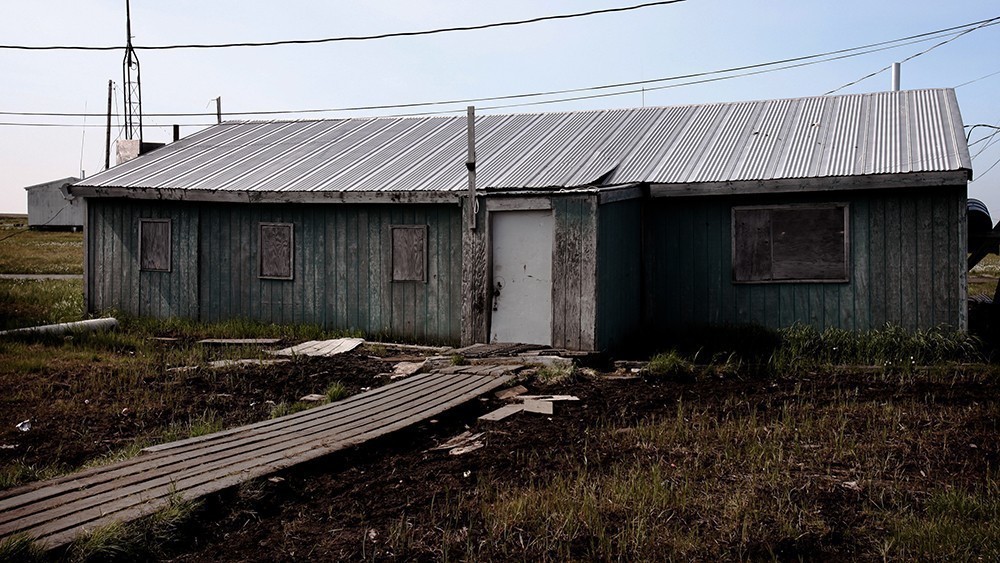
Newtok © Phil Daquila 2009
A comprehensive relocation framework
In a video recorded just before his visit to Alaska, President Obama said, “What’s happening in Alaska isn’t just a preview of what will happen to the rest of us if we don’t take action. It’s our wake-up call” (The White House, 2015).
While his attempt to shine a light on the situation in Alaska is admirable, these words might well rub the people of Newtok the wrong way. After all, they have been trying to take action for decades but their relocation efforts haven’t been very successful thus far. It is clear that progress will continue to be painfully slow until the federal government addresses the many hurdles towns like Netwok face in their efforts to relocate.
A step in the right direction would include a number of modifications of and additions to the FEMA grant programs available to tribes in Alaska. For example, in her discussion of erosion-induced displacement in Newtok, attorney Ashley Rawlings suggests that there should be a cost-sharing exception for tribes so they can become eligible for grants that have such requirements (2015). Furthermore, Rawlings calls for an amendment of the Stafford act to allow a community relocation grant program to be established under existing FEMA framework. This would allow communities such as Newtok to have a second option when agencies have decided that mitigation is no longer effective. A combination of the cost-sharing exemption and the relocation option would mean that tribes would have access to federal relocation funding (Rawlings, 2015).
Bronen also thinks the Stafford act should be amended. She argues that the act should include gradual geophysical processes, such as erosion, in the statutory definition of disaster. Additionally, she calls for the creation of “an adaptive governance relocation framework [that] would incorporate all of the institutional mechanisms to protect people in the places where they live and also create new mechanisms to implement a relocation process so that national, state, local and tribal governments can dynamically shift their efforts from protection in place to managed retreat and community relocation” (Bronen, 2015).
By modifying FEMA programs and creating a comprehensive relocation framework that assists with and funds communities’ relocation efforts, the United States can lead the rest of the world in regards to climate refugees, according to Bronen.
“The United States can create a model adaptation strategy that facilitates an effective transition from protection in place to community relocation that can serve as a model for governments throughout the world” (Bronen 2013).
Acknowledgment
I would like to thank Phil Daquila for making his photography available.
Phil Daquila is a documentary photographer, video producer, and website developer with a passion for sharing the craft. International experience producing documentary shorts in France, Thailand, Chile, the Dominican Republic and others. Videos have appeared in the Wall Street Journal and Washington Post and multimedia work as producer and coach has been recognized by National Press Photographers Association, Pictures of the Year International, College Photographer of the Year, Society for News Design, and Online Journalism Awards. Also produces documentary-style marketing videos for small businesses and top universities, with clients such as DukeEngage, UNC Global, and UNC Kenan-Flagler Business School. Daquila holds an MA from the University of North Carolina at Chapel Hill and a BSJ from Ohio University.
Contact Phil Daquila:
Linkedin
Video Portfolio
Twitter: @phildaquila
Email: writeme@phildaquila.com
References
Barnhardt, Carol. “A History of Schooling for Alaska Native People” Journal of American Indian Education, Volume 40, Number 1.
Bronen, Robin. 2015. “Climate-Induced community relocations: using integrated social-ecological assessments to foster adaptation and resilience” Ecology & Society Volume 20 Issue 3.
Bronen, Robin. 2013. Climate-Induced Displacement of Alaska Native Communities. Brookings Project on Internal Displacement. http://www.brookings.edu/~/media/Research/Files/Papers/2013/1/30%20arctic%20alaska%20bronen/30%20climate%20alaska%20bronen%20paper.pdf (accessed on April, 22, 2016).
Bronen, Robin, F. Studart Chapin, III. 2013. “Adaptive governance and institutional strategies for climate-induced community relocations in Alaska” Proceedings of the National Academy of Sciences of the United States of America, Volume 110 Issue 23. http://www.ncbi.nlm.nih.gov/pmc/articles/PMC3677491/ (accessed on April 22, 2016).
Community of Newtok and the Newtok Planning Group. 2011. Mertarvik, a community that builds together for the safe and healthy future of Newtok. https://www.commerce.alaska.gov/web/Portals/4/pub/Mertarvik_Relocation_Report_final.pdf (accessed on April 22, 2015).
DeMarban, Alex. 2013. “Brookings: Federal funding, framework needed to help eroding villages” Alaska Dispatch News, January 30, 2013. http://www.adn.com/article/20130130/brookings-federal-funding-framework-needed-help-eroding-villages (accessed on April 23, 2016).atla
EPA. 2016. Climate Impacts in Alaska https://www3.epa.gov/climatechange/impacts/alaska.html (accessed on April 22, 2016).
GAO. 2009. Alaska Native Villages – Limited Progress Has Been Made on Relocating Villages Threatened by Flooding and Erosion. http://www.gao.gov/new.items/d09551.pdf (accessed on April 22, 2016)
Newtok Village. 2015. Tribal Hazard Mitigation Plan Update https://www.commerce.alaska.gov/web/Portals/4/pub/2015_Newtok_HMP.pdf (accessed on April 22, 2016).
Miller, David, and Kenneth Murphy. 2013. “Written testimony of FEMA Federal Insurance and Mitigation Administration Associate Administrator David Miller, and FEMA Region X Regional Administrator Kenneth Murphy for a Senate Committee on Homeland Security and Governmental Affairs, Subcommittee on Emergency Management, Intergovernmental Relations, and the District of Colombia field hearing titled “Extreme Weather in Alaska: State and Federal Response to Imminent Disasters in the Arctic.” https://www.dhs.gov/news/2013/09/13/written-testimony-fema-senate-homeland-security-governmental-affairs-subcommittee (accessed on April 22, 2016).
Obama, Barack. 2015. “My Visit to Alaska: Closing Thoughts” https://medium.com/@PresidentObama/my-visit-to-alaska-closing-thoughts-e9528ba4e268#.hqmzcixsq (accessed on April 22, 2016).
Rawlings, Ashley. 2015. “Erosion-Induced Community Displacement in Newtok, Alaska and the Need to Modify FEMA and NEPA to Establish a Relocation Framework for a Warming World” Seattle Journal of Environmental Law Volume 5, Issue 1.
Semuels, Alana. 2015. “The Village That Will Be Swept Away” The Atlantic, August 30, 2015. http://www.theatlantic.com/business/archive/2015/08/alaska-village-climate-change/402604/#article-comments (accessed on April 23, 2016).
State of Alaska. 2016. Newtok Planning Group, Mertarvik Housing. https://www.commerce.alaska.gov/web/dcra/planninglandmanagement/newtokplanninggroup/mertarvikhousing.aspx (accessed on April 22, 2016).
State of Alaska. 2016i. Newtok Planning Group, Early Efforts to Address Erosion. https://www.commerce.alaska.gov/web/dcra/PlanningLandManagement/NewtokPlanningGroup/NewtokVillageRelocationHistory/NewtokHistoryPartTwo.aspx (accessed on April 23, 2016).
The White House. 2015. President Obama is Going to Alaska. Here’s Why. https://www.whitehouse.gov/webform/president-obama-going-alaska-heres-why (accessed on April 23, 2016).
U.S. Army Corps of Engineers. 2009. Alaska Baseline Erosion Assessment. Study Findings and Technical Report. http://climatechange.alaska.gov/docs/iaw_USACE_erosion_rpt.pdf (accessed on April 22, 2016)
-
According to Bronen, current federal disaster response legislation, the Stafford Act and its amendments, require that funding be spent on repairing and rebuilding in the original location of the disaster. This means that communities whose location is no longer habitable, or that are located entirely within floodplains, are unable to receive government funding to repair and rebuild. ↩
-
The PDM standard cost share division is 75 percent federal and 25 percent tribal, local, state, or other contributions. However, the PDM also offers a 90/10 cost share incentive to communities that meet the definition of “small and impoverished,” which is determined by criteria addressing community population, per capita income, and unemployment rates. ↩
Elke Weesjes Sabella is former editor of the Natural Hazards Observer. She joined the staff in December 2014 after a brief stint as a correspondent for a United Nations nonprofit. Under her leadership, the Observer was revamped to a more visual format and one that included national and international perspectives on threats facing the world. Weesjes was the editor of the peer-reviewed bimonthly publication United Academics Journal of Social Sciences from 2010 to 2013.
Weesjes Sabella also worked as a research associate for the Center for Disaster and Risk Analysis, formerly located at Colorado State University (although no longer active). In that role, she collected and analyzed data and translated research findings for a broader audience. She played a central role in finalizing the Disaster Preparedness among Childcare Providers in Colorado project, which examines all-hazards preparedness in daycares and in-home childcare across Colorado. She co-authored the report based on the first stage of the project, which was funded by Region VIII of the Federal Emergency Management Agency.
Weesjes Sabella specializes in cultural memory and neighborhood/community change in times of acute and chronic stress. She has published articles on the impact of drought on farming communities in Kansas, the effects of Superstorm Sandy in Far Rockaway, Queens, urban renewal in the Bedford-Stuyvesant neighborhood in Brooklyn, and health services for vulnerable populations in the South Bronx.
Weesjes Sabella received her PhD from the University of Sussex. Her dissertation, Children of the Red Flag: Growing up in a Communist Family During the Cold War (2012), as well as the majority of her publication record, share the common methodology of understanding culture and identity through oral history.